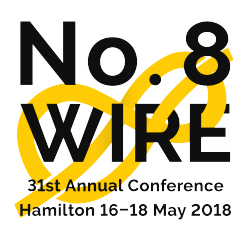
ILANZ 2018 was another hugely energising and enjoyable event. Thank you to everyone involved in organising it!
The official theme of this year’s ILANZ was “No 8 wire”, as a nod to our in-house lawyers' ingenuity and ability to innovate with limited resources. Last year, I used this term in my blog to describe some of the cobbled-together solutions delegates were using – it was a term of endearment. This year, I'm a little less certain we should be celebrating this.
But, rather than sitting on the fence… (yes, I've recently become a Dad and now can legitimately use Dad jokes), ILANZ 2018 has made me appreciate that in-house lawyers have many more tools in the shed than the trusty No 8 wire. When used flippantly, the No. 8 wire mentality and the sense of comfort it provides is actually holding innovation back.
As this recent story on Waikato company Halter shows, even No. 8 wire is under the threat of fences being replaced by a solar powered audio app that not only acts as a fence but can also move stock around for the farmer. Backed by Peter Beck and K1W1, it’s described as having billion dollar prospects.
It's true that a lot of in-house teams don’t have the luxury of the shed, let alone the immediate ability to buy other tools, but ILANZ 2018 confirmed that it doesn't take much resource to make a real difference to our organisation and colleagues. We just have to get started, and make the case for the more professional approach technology now enables.
The fear of the unknown and change
There is some comfort in continuing to use No. 8 wire. I get it. You know it, it's worked well enough, and you don't need to change your current processes.
But for me, the legal profession needs to move on from the "this is just the way it has always been" and "it's good enough" mentality.
It's no longer good enough for our lawyers to feel overworked and undervalued, to do mind-numbing work, to bear the brunt of unsatisfied internal and external clients, if this can be easily solved by new approaches.
It's no longer good enough that we automatically put anything new into the "too hard" or “too busy” baskets, or class it as a "nice to have". What's just nice to have for someone making the decisions, is not necessarily just nice to have for someone really struggling at the coal face. The old school thinking of "if I went through the pain, then they should have to, too" is regressive, at a time when the profession is trying to be progressive.
While there is some comfort in continuing to use the No. 8 wire, Gilbert Enoka made it clear that some discomfort is required to close the gap from where you are now to where you want to be (remember: dream big). If it takes a few hours of your time, to save hundreds of hours of team time each year, isn’t that a good use of your time? The All Blacks succeed because they always look for the next improvement.
There are tools out there
In fact, there are now massive global organisations dedicated to putting these tools in front of the legal industry, such as the Corporate Legal Operations Consortium (CLOC). Mick Sheehy is the chair and founder of CLOC Australia, and the LawVu team has just returned from the annual Las Vegas event.
This year, ILANZ had a real focus on actionable advice, with speakers providing insights into what's worked, what hasn’t, how they got there, what’s next, and canvassing different tools and approaches.
I'm not sure if it was by good luck or good design, but it made a lot of sense that the sessions run by Telstra and Housing New Zealand were back-to-back, given they both discussed automation as a tool that brought meaningful results.
Mick Sheehy from Telstra explained how, in 2016, they achieved time savings of 40,000 hours. The secret? A combination of document automation, reduction in time spent reporting, reduction in internal lawyer-only meetings, and reduction in review of internal communications.
Yazmin Juned from Housing New Zealand then went into a more in-depth discussion of how they, on average, have reduced the time taken to produce contracts by 75% with document automation, and how document automation has had a positive impact on both the legal team, and the businesses they support. For example, their turnaround time to the business in relation to all construction contracts has reduced from an average of 6.5 days to 2.8 days. You can find out more details of the Housing New Zealand case study here.
Gilbert Enoka challenged us to set more challenging goals for ourselves. 5-10% improvements feel safe to write down. We probably could get there with a bit of No. 8 wire and working a bit harder, but it also won’t matter much if we don’t get there and often we don’t. 5 to 10 times improvements though – that’s big! But, as experience has proven, it's attainable!
How do I get started? Take small steps
What advice did each of LawVu, Telstra, Housing New Zealand, and Gilbert Enoka have in common? Start small – do something, and keep going! Not only does small mean low risk, because you can adapt with minimal business impact, but it also provides the data and business case to do something bigger, if the small steps are successful.
Dream big, start small, close the gap.
Does it still make sense to continue to buy meters of No 8 wire without at least looking into some Halters?




